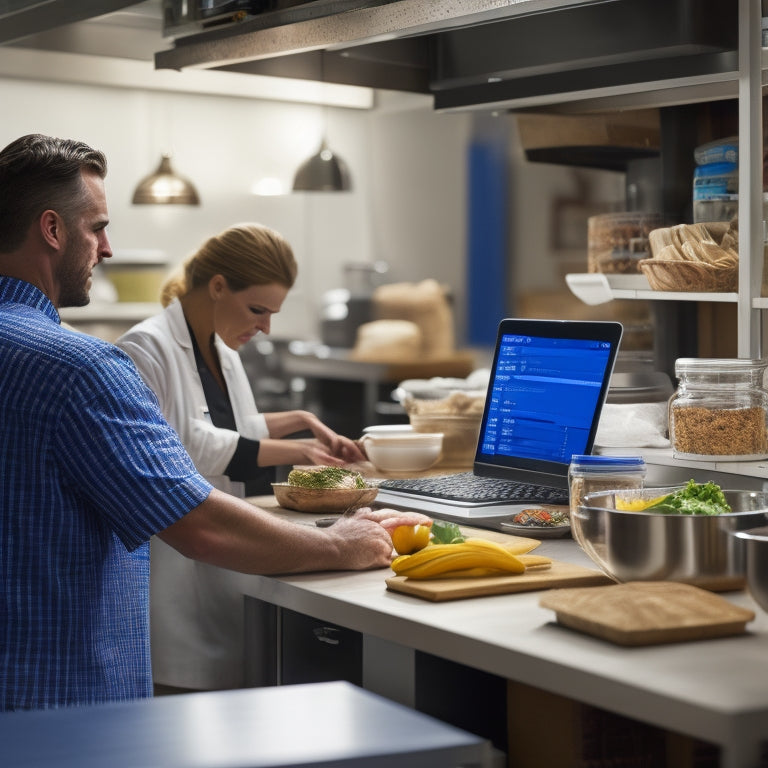
Mastering Restaurant Inventory Management for Optimal Efficiency
Share
Mastering restaurant inventory management for best efficiency requires a thorough system that maintains ideal stock levels, controls costs, and optimizes efficiency. Effective inventory tracking is vital, achieved through precise counts and demand forecasting. Setting par levels and reorder points ensures inventory control. Streamlining operations through technology integration and automation reduces waste and overstocking. Data-driven decisions lead to improved customer satisfaction. By adopting best practices, such as systematic approaches, precise stock level monitoring, and data-driven decision-making, restaurants can overcome common challenges and achieve best efficiency. Discover how to implement these strategies to reveal the full potential of your inventory management system.
Key Takeaways
• Implement a comprehensive inventory management system to maintain ideal stock levels and control costs.
• Leverage technology, such as inventory tracking software, to automate and optimize inventory operations.
• Conduct precise inventory counts and forecast demand to achieve stock optimization and reduce waste.
• Establish a systematic approach to inventory management, including accurate product categorization and monitoring.
• Adopt data-driven decision-making and inventory optimization strategies, like vendor-managed inventory and just-in-time delivery, to improve efficiency.
Restaurant Inventory Management Essentials
At the core of a well-run restaurant lies a comprehensive inventory management system. This system encompasses the fundamental principles and processes necessary for maintaining ideal stock levels, controlling costs, and ensuring smooth kitchen operations.
Effective inventory tracking is vital in achieving stock optimization. The goal is to maintain best inventory levels that meet customer demand while minimizing waste and excess inventory. This is achieved through precise inventory counts, setting par levels and reorder points, and forecasting demand based on historical sales data.
Streamlining Inventory Operations
By implementing efficient inventory management strategies, restaurants can eliminate unnecessary complexities and optimize their inventory operations, thereby reducing costs and improving overall performance. Streamlining inventory operations involves leveraging technology, such as inventory tracking software, to automate tasks and guarantee accuracy. This enables restaurants to optimize stock levels, reducing waste and overstocking.
Stock level optimization is critical, as it guarantees that inventory levels align with demand, minimizing excess inventory and reducing costs. By streamlining inventory operations, restaurants can free up resources, improve efficiency, and make data-driven decisions. This, in turn, leads to improved customer satisfaction, increased revenue, and enhanced competitiveness in the market.
Overcoming Inventory Management Challenges
Regularly, restaurants face a variety of challenges that impede their ability to maintain ideal inventory levels, including inaccurate forecasting, manual tracking errors, and inefficient storage practices.
To overcome these obstacles, restaurants must adopt effective inventory forecasting techniques, such as analyzing historical sales data and seasonal trends, to guarantee accurate predictions of demand.
Implementing communication strategies between kitchen staff and inventory managers is also essential, as it enables real-time updates on inventory levels and minimizes discrepancies.
By addressing these challenges, restaurants can optimize their inventory management, reduce waste, and improve overall efficiency.
Leveraging Technology for Efficiency
Restaurant inventory management can further benefit from the strategic integration of technology. This enables real-time tracking, automated data analysis, and optimized inventory control, streamlining operations and increasing overall efficiency.
By leveraging technology, restaurants can overcome manual errors, reduce waste, and optimize inventory levels. This integration also enables data-driven decision-making, allowing restaurants to make informed purchasing decisions and reduce costs.
- Automated inventory tracking and alerts for low stock levels
- Real-time data analysis for demand forecasting and supply chain optimization
- Integration with point-of-sale systems for seamless inventory management
- Customizable software solutions for tailored inventory control
Best Practices for Inventory Control
Effective inventory control relies on establishing and maintaining a systematic approach to inventory management. This encompasses accurate product categorization, precise stock level monitoring, and data-driven decision-making.
This involves implementing inventory control techniques such as ABC analysis, which prioritizes high-value items, and the Pareto principle, which focuses on the most profitable products.
Additionally, restaurants should adopt inventory optimization strategies like vendor-managed inventory and just-in-time delivery to minimize stockouts and overstocking. By leveraging these best practices, restaurants can streamline their inventory control processes, reduce waste, and optimize their stock levels.
This, in turn, can lead to improved profitability, enhanced customer satisfaction, and increased competitiveness in the marketplace.
Frequently Asked Questions
How Often Should I Count and Update My Restaurant's Inventory?
To sustain accuracy, it is recommended to count and update restaurant inventory at least weekly, or bi-weekly for slower-moving items, utilizing precise updating procedures to guarantee real-time tracking and best inventory frequency.
Can I Use the Same Inventory Management System for Multiple Locations?
When considering a multi-location inventory management system, centralized control and data synchronization are essential. A unified platform enables real-time tracking, eliminating discrepancies and ensuring consistency across locations, while also facilitating data-driven decisions and optimizing inventory levels.
How Do I Determine the Optimal Inventory Levels for Seasonal Menu Items?
To determine best inventory levels for seasonal menu items, conduct seasonal demand forecasting, calculate the inventory turnover rate, and integrate menu planning with cost analysis to guarantee precise stock levels that meet fluctuating demand while minimizing waste and excess.
What Is the Best Way to Manage Inventory for Catering and Events?
To manage inventory for catering and events, establish strong vendor relationships, utilize accurate forecasting methods, and implement waste reduction strategies to guarantee cost control, thereby optimizing inventory levels and minimizing overstocking or shortages.
Can I Integrate My Inventory Management System With My Accounting Software?
To integrate inventory management with accounting software, guarantee compatibility by selecting software with seamless API integration or built-in connectors, enabling real-time data synchronization and automating financial reconciliations.